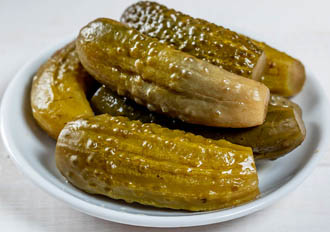Dill Pickle
Dill pickle, also known as dill gherkin, is a type of cucumber that has been preserved through the process of fermentation or pickling.
Dill pickles are commonly enjoyed as a condiment or snack on their own. They are popular in many cuisines and are loved for their refreshing and zesty taste. Whether you're biting into a whole dill pickle or enjoying its chopped form in relishes or tartar sauce, this pickle variety adds a burst of flavor and texture to any dish.
 |
| Gherkins. Courtesy: Marco Verch |
Process of dill pickling
Pickling dill cucumbers is a popular method of preserving and flavoring cucumbers. The process typically involves brining the cucumbers with dill, garlic, and other spices to create delicious and tangy dill pickles. Remember to follow proper food safety practices and guidelines when pickling to ensure the safety and quality of your dill pickles.
Ingredients: Required items are fresh cucumbers suitable for pickling (small to medium-sized), fresh dill heads or dill seeds, garlic cloves, pickling salt (non-iodized) or kosher salt, white vinegar (5% acidity), water. Optional spices such as black peppercorns, mustard seeds, coriander seeds, red pepper flakes, etc.
Procedure:Wash the cucumber thoroughly to remove any dirt or debris. Trim off both ends of each cucumber.
To prepare the brine combine water and vinegar in a ratio of 1:1 in a large pot. Add salt to the mixture according to taste.
Place a few dill heads or a tablespoon of dill seeds in a clean and sterilized jar. Add garlic cloves and any other desired spices. Then pack the jar with prepared cucumbers tightly, and fill the jars with the brine, leaving about 1/2 inch of headspace at the top. Wipe the jar rims with a clean, damp cloth to ensure a good seal.
Place sterilized lids on the jars and screw the bands on firmly, but not overly tight. If you plan to store the pickles long-term, you can process the jars in a water bath canner. Store the jars in a cool, dark place, such as a pantry or cellar.
Labeling: It's a good practice to label the container with the date of storage. This will help you keep track of how long the pickles have been stored and when they might need to be consumed.
Let the cucumbers ferment for at least a week to develop the flavors. The longer they ferment, the stronger the flavor will be. Check the jars periodically to ensure the lids are sealed and there are no signs of spoilage.
After the fermentation period, the dill pickles are ready to eat. You can refrigerate them for a crisper texture or keep them at room temperature for a softer pickle.
Health benefits of Dill pickle
Low in calories: Since cucumbers themselves are low in calories and the fermentation process doesn't add any significant calories, making them a popular choice for those looking for a low-calorie snack. 3.5 Oz (100 g) of fresh pickle holds 14 calories and 0.43 g of total fats.
Dill pickles Probiotics: Dill pickles are fermented, which means they undergo a natural fermentation process that creates beneficial bacteria known as probiotics. Probiotics can help support a healthy digestive system and enhance gut health.
Electrolytes: The brine in dill pickles often contains sodium, potassium, calcium, and magnesium. These electrolytes are essential for maintaining proper hydration, muscle function, and nerve transmission in the body.
Antioxidants: Dill pickles contain antioxidants, such as vitamin C and other compounds like quercetin. Antioxidants help protect the body against damage caused by harmful free radicals, reducing the risk of chronic diseases and inflammation.
Source of vitamins and minerals: Dill pickles contain small amounts of vitamins and minerals, including vitamin K, which is important for blood clotting and bone health, as well as calcium and phosphorus, which are essential for bone strength.
Hydration: Pickles are made with cucumbers, which have a high water content. Eating dill pickles can contribute to your overall hydration, especially in hot weather or during physical activity.
Craving reduction: Dill pickles have a strong and tangy flavor, which can help satisfy cravings for salty or crunchy foods. Choosing dill pickles as a snack option may be a healthier alternative to other high-calorie or processed snacks.
Caution: It is important to note that dill pickles are often high in sodium due to the brining process. If you are watching your sodium intake, you may want to consume them in moderation or look for low-sodium pickle options. Additionally, individuals with certain health conditions, such as high blood pressure or kidney problems, should be cautious about their sodium intake and consult with a healthcare professional if needed.
| Principle | Nutrient Value | Percent of RDA |
|---|---|---|
| Energy | 22 Kcal | 1% |
| Carbohydrates | 3.9 g | 3% |
| Protein | 2.2 g | 4% |
| Total Fat | 0.3 g | 1.5% |
| Cholesterol | 0 mg | 0% |
| Dietary Fiber | 2.8 g | 7% |
| Vitamins | ||
| Folates | 159 μg | 40% |
| Niacin | 0.678 mg | 4% |
| Pantothenic acid | 0.178 mg | 3.5% |
| Pyridoxine | 0.153 mg | 12% |
| Riboflavin | 0.093 mg | 7% |
| Thiamin | 0.068 mg | 7% |
| Vitamin A | 9900 IU | 330% |
| Vitamin C | 130 mg | 144% |
| Electrolytes | ||
| Sodium | 21 mg | 1.4% |
| Potassium | 449 mg | 9.5% |
| Minerals | ||
| Calcium | 210 mg | 21% |
| Copper | 0.075 mg | 8% |
| Iron | 1.5 mg | 19% |
| Magnesium | 11 mg | 3% |
| Manganese | 0.407 mg | 18% |
| Selenium | 0.8 µg | 1.5% |
| Zinc | 0.17 mg | 1.5% |
Buying
Dill pickles come in various forms, such as whole pickles, spears, chips, or slices. Whole pickles are great for snacking, while spears or slices are convenient for adding to sandwiches. Decide how you plan to use them. If you enjoy a crunchy texture, look for pickles that are labeled as "crunchy" or "extra crisp."
Dill pickles are typically available in jars or plastic containers. Look for the date of expiry on the packaging. Organic products or homemade pickles can offer a unique flavor and allow you to customize the ingredients to your liking.
The flavor of dill pickles can vary based on the spices and ingredients used in the brine. Traditional dill pickles typically have a tangy and sour taste with a prominent dill flavor. Some varieties may include additional spices like garlic, mustard seeds, or red pepper flakes for added complexity.
When buying dill pickles, check the expiration date to ensure they are fresh. Pickles that have been sitting on the shelf for a long time can lose their crispness and flavor.
Storing
To store dill pickles, place them in the refrigerator to maintain their quality and extend their shelf life. Refrigeration helps preserve their crispness and flavor. Make sure your refrigerator is set to a temperature below 40°F (4°C).
Dill pickles stored in the refrigerator can typically remain good for several months, but their quality might start to decline after a while. It's best to consume them within 1 to 2 months for optimal taste and texture. If you notice the pickles become soft, slimy, or develop a disagreeable odor, discard them.
Food uses
Dill pickle fries are a delicious and popular snack or side dish. When serving pickles, use clean utensils to avoid introducing bacteria into the jar. Avoid touching the remaining pickles with your fingers.
 |
| Dill pickle sandwich. Courtesy: jeffreyw |
Pickle Spears: Serve dill pickle spears alongside sandwiches, burgers, or as a side dish for barbecues and picnics.
Pickle Roll-Ups: Roll up slices of deli meat, such as ham or turkey, with a dill pickle spear inside. Secure with toothpicks and serve as a fun appetizer.
Pickle Dip: Finely chop dill pickles and mix them with cream cheese, sour cream, and a dash of garlic powder. Serve the pickle dip with crackers, pretzels, or vegetable sticks.
Pickle Wraps: Spread a thin layer of cream cheese or hummus on a slice of deli meat, place a dill pickle spear on top, and roll it up. Slice the roll into bite-sized pieces for a quick and easy snack.
Pickle Slaw: Add chopped dill pickles to coleslaw for an extra tangy and flavorful twist. It goes well with sandwiches, hot dogs, or as a side dish for grilled meats.
Pickle Pizza: Slice dill pickles and add them as a topping to your homemade or store-bought pizza. They add a zesty and refreshing flavor to the cheesy goodness.
Pickle Garnish: Use dill pickle slices as a garnish for hamburgers, sandwiches, or sliders. They add a crisp and tangy element to your favorite dishes.
Pickle Salsa: Create a unique salsa by combining diced dill pickles, tomatoes, onions, jalapeños, lime juice, and cilantro. Serve it with tortilla chips or as a topping for grilled fish or chicken.
Pickle Potato Salad: Add chopped dill pickles to your potato salad for a flavorful twist. The tanginess of the pickles pairs well with the creamy dressing and adds a nice crunch.
Pickle fry: They are typically made by coating dill pickle spears or slices in a seasoned batter and then frying them until crispy. Serve the dill pickle fries immediately while they're still hot and crispy. You can enjoy them on their own or serve them with a dipping sauce of your choice, such as ranch dressing or spicy mayo.
Safety profile
Dill pickles are generally safe to consume for most individuals. However, some individuals may be allergic to certain ingredients used in dill pickles, such as vinegar or spices. If you have known allergies, it's essential to read the ingredient labels carefully or prepare homemade pickles using ingredients that you are not allergic to.
Pickles, including dill pickles, are typically high in sodium due to the pickling process. Individuals on low-sodium diets or those with certain medical conditions, such as high blood pressure, may need to limit their intake of dill pickles to manage their sodium intake.
Some commercial pickle products may contain sodium benzoate as a preservative. While considered safe for most individuals, some people may experience adverse reactions to this ingredient, such as allergies or asthma-like symptoms.
(Medical Disclaimer: The information and reference guides on this website are intended solely for the general information of the reader. It is not to be used to diagnose health problems or for treatment purposes. It is not a substitute for medical care provided by a licensed and qualified health professional. Please consult your health care provider for any advice on medications.)
≺≺-Back to Cucumber from Dill pickle.
≺≺-Back to Home page.
Further Resources:
Cucumber Pickles and Fermentations. (pdf, opens in new window).
USDA National Nutrient data base (opens in new window).
Preparing and Canning Fermented Foods-Dill pickles. (opens in new window).